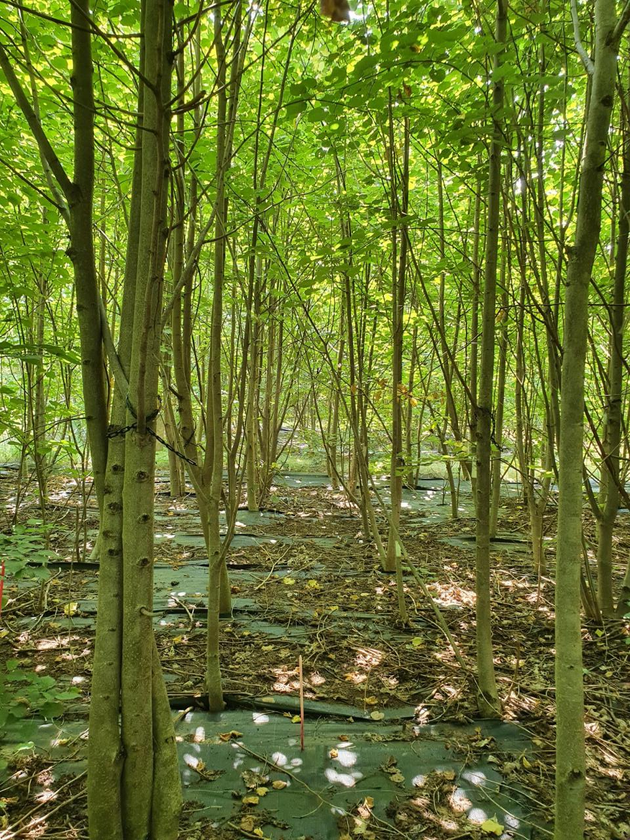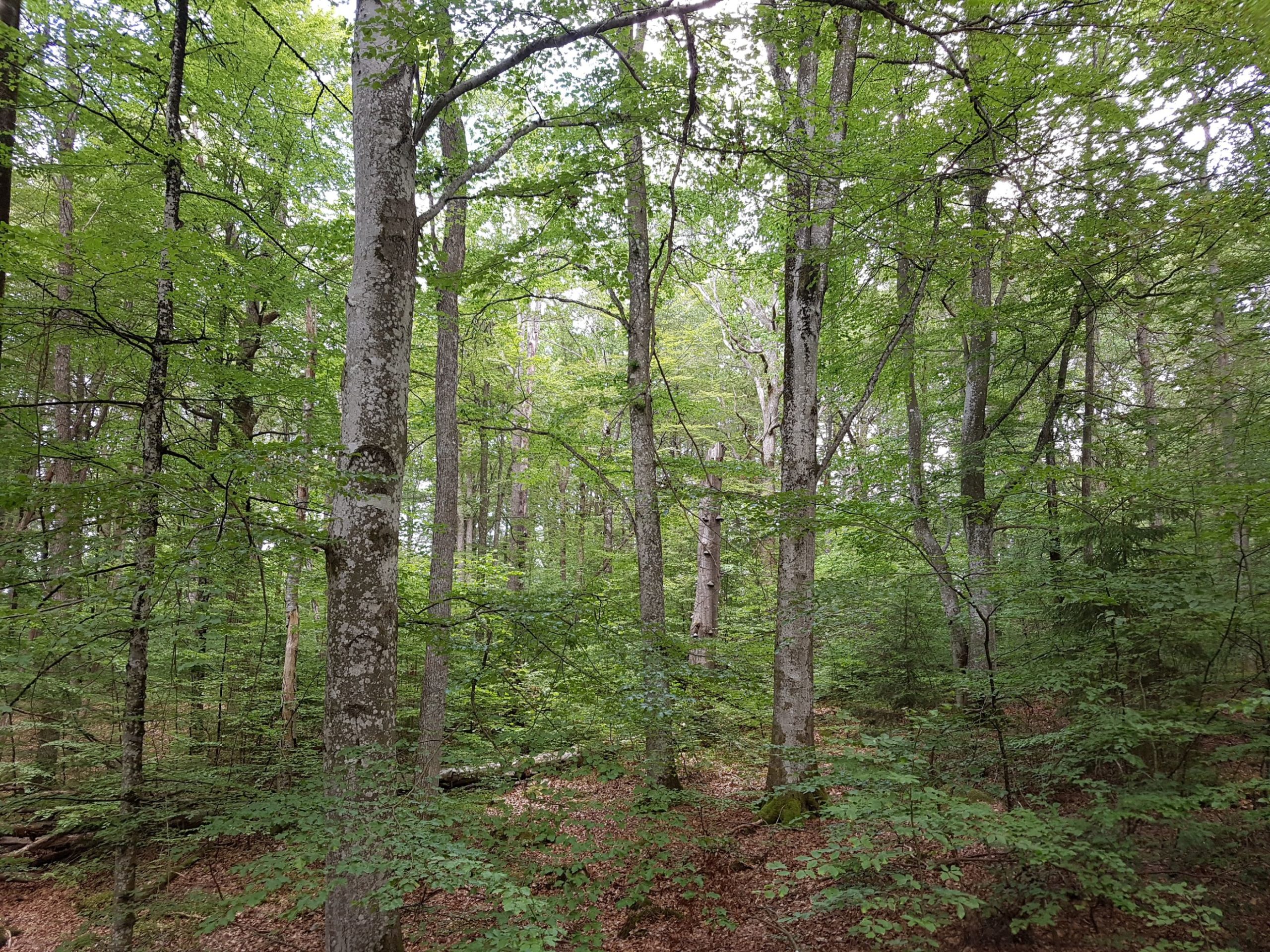Forests are not only beautiful to look at, but also perform a number of important ecosystem functions. For example, they provide a home for many animals and plants, clean our air, and store carbon. Many scientific studies have shown that the functionality of forests improves when several tree species grow together in a forest. Research that investigates the effects of biodiversity on the functioning of ecosystems is known as functional biodiversity research: in experiments, species diversity is altered in order to better understand the relationship between biodiversity and ecosystem functions. An important one of these ecosystem functions is productivity, i.e. the growth of trees. This not only increases their wood reserves but also binds CO2 from the atmosphere through photosynthesis and stores it in the tree in the form of carbon. Many studies have already shown that the productivity of a forest increases as the number of tree species increases. What has been less studied, however, is: Why is this the case?
Tree species and fungi – A special experimental design
This question was addressed by Tama Ray and her colleagues (2023), including Andreas Fichtner and Benjamin Delory from the Institute of Ecology at Leuphana University Lüneburg (Delory meanwhile: Utrecht University). For their study, they used data from the myDiv experiment. MyDiv is an experiment that falls under the functional biodiversity research described above. The experiment aims to better understand the relationship between above- and belowground interactions in tree species mixtures. This is based on the assumption that forest stands rich in tree species with different types of mycorrhiza function best. A mycorrhiza is a complex cohabitation between fungi and plants from which both benefit. The fungi are in contact with the fine roots of the plant and improve nutrient and water uptake for the plant and in return receive carbohydrates produced by the plant. There are many different types of mycorrhiza, which can be roughly categorised as arbuscular mycorrhiza (AM) and ectomycorrhiza (EM). Trees at temperate latitudes can be associated with either AM or EM or with both types of mycorrhiza. AM and EM function differently and have different specialisations.
In the MyDiv experiment, both the influence of aboveground and belowground diversity on productivity was analysed together. This means that there were two diversity variables: Firstly, the number of tree species (along the gradient: Monoculture, two tree species mixed, and four tree species mixed). Secondly, the types of mycorrhiza (AM, EM or mixed AM and EM). The trees were planted in 2015 near Bad Lauchstädt in Saxony-Anhalt, Germany.

What did the scientists expect?
Ray and colleagues have hypothesised that the greater diversity of tree species aboveground results in a more complex structure of the forest, i.e. leads to an increase in structural complexity. Structural complexity characterises the differing distribution of tree biomass in the three-dimensional space: different tree species have different tree heights and form differently structured crowns and thus use the space in the canopy more diversely than just one tree species would. This could allow the trees to utilise the available light more efficiently. As all plants need light for photosynthesis, in addition to water and nutrients, such more efficient utilisation of light could result in increased photosynthetic performance and thus increased growth. The assumption was similar for a higher diversity of mycorrhiza types: Due to the different specialisation of the various types, the scientists expected that the belowground resource use of nutrients and water is more efficient in stands with different mycorrhiza types and thus also contributes to increased productivity.
How do you measure the complexity of a forest structure?
Not only the experimental setup but also the measurement method in this experiment is special. Conventional measurement methods analyse structural complexity in two dimensions. In this experiment, however, the structural complexity was recorded three-dimensionally using terrestrial laser scanning, and a structural complexity index (SSCI) was created from this. This means that the specific distribution of leaves, branches, and trunks of the trees in space was recorded by a laser and translated into a numerical value. Productivity was measured annually based on the trunk diameter and tree height of each tree.
Surprising results
The scientists discovered several things:
- Interestingly, contrary to expectations, the diversity of mycorrhizal types did not influence the productivity of the young forest. The scientists suspect that this effect may only play a role in older forests than the young forest of the project, as other studies have observed such effects in older forests.
- With increasing tree species diversity, structural complexity increases.
- With this increasing structural complexity, productivity increases. In other words, the more complex the structures of the tree stands, the better the forests grow.
In order to test the assumed effect of increased light utilisation, the scientists measured the light incidence on the forest floor. They found that the less light reaches the forest floor, i.e. the more light was previously captured by the tree canopy, the stronger the correlation between structural complexity and productivity. Ray and his colleagues have therefore concluded that increasing the structural complexity of the canopy allows the forest to grow better because the available light is then utilised more efficiently, meaning that more light is available for photosynthesis and thus for growth. The increasing diversity of tree species therefore has an indirect effect on the growth of the forest because it makes the structure of the forest more complex, which in turn allows the forest to grow better (see overview). In the experiment, forests with a more complex structure grew almost twice as fast as forests with a less complex structure.

Miracle tree species or team effect?
In the next step, the scientists wanted to find out whether the observed increase in productivity was due to a specific tree species or whether it was caused by the mixing effect. To this end, they calculated the so-called “overyielding”. This describes the increased growth of a tree species that only occurs when it is mixed with other tree species compared to a monoculture. So, if a beech in monoculture would grow 5 m3 per tree per year, but in a mixture with oaks, for example, it would grow 8 m3 per year, then this additional growth of 3 m3 per year would describe the overyielding. The overyielding therefore describes the net biodiversity effect of the mixture of tree species on the productivity of the individual tree species (which grows in this mixture). This effect can be mathematically divided into the species identity effect and complementarity effects. The former would be an effect for which a particular tree species is responsible, the latter an effect caused by the mixture of tree species. This can be compared to a football team: Does a team win because it has a particular football player on the team who plays much better than the others, or does it win because the team as a whole plays so well together? The effects in this experiment could largely be explained by the team effect, i.e. they are mainly complementarity effects.

Light-loving and shade-tolerant complement each other well
The scientists found that structural complexity explains half of the variation in productivity and that almost two-thirds of this can be attributed to this mixing effect of tree species alone. This strong effect of the mixture of tree species itself could be traced back by the scientists mathematically. They found that the effect can be explained most strongly by different shade tolerances of trees. Birches, for example, do not tolerate shade well, but beeches do and can therefore thrive under the fast-growing birches. Together, this gives them more space in which they can grow optimally and therefore more complexly. Thus, the more diverse the shade tolerances of trees in a forest are, the better and more complex the space can be utilised, which means more light can be captured and thus more light is available for photosynthesis, so the forest grows better (see overview). In addition, taxonomic diversity (i.e. the different ancestral histories of trees) also influences this stronger growth in mixed tree species. The scientists have not yet been able to explain exactly why this is the case, but they believe it could be due to the different shapes and branching patterns of the tree crowns of the various tree species.
How can these findings be used? – Climate change and drones
These results provide valuable implications for practice, including the restoration of forests: For example, tree stands should be designed in such a way that they contain several tree species that have different light requirements. This would allow the forests to grow as quickly as possible and store larger amounts of carbon aboveground, which is particularly relevant in view of climate change. In addition, the structural complexity could be used as a proxy for productivity in the future based on the results. In the course of new satellite-based methods and drone applications, the structural complexity and thus productivity of a forest could be assessed relatively quickly and over a large area, thus, for instance, improving the predictive power of carbon models.
If you want to delve deeper into the topic, you can find the paper by Ray and colleagues here: Ray, T., Delory, B. M., Beugnon, R., Bruelheide, H., Cesarz, S., Eisenhauer, N., Ferlian, O., Quosh, J., von Oheimb, G., & Fichtner, A. (2023). Tree diversity increases productivity through enhancing structural complexity across mycorrhizal types. Science Advances, 9(40), eadi2362. https://doi.org/10.1126/sciadv.adi2362
Cover picture: Structurally rich beech forest in Sweden (Photo: Andreas Fichtner).
